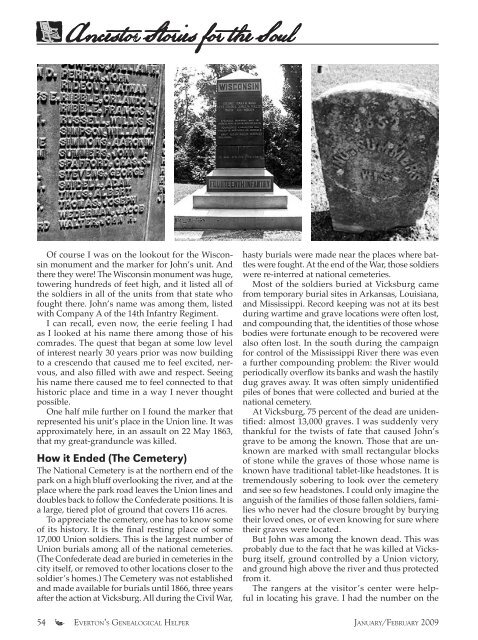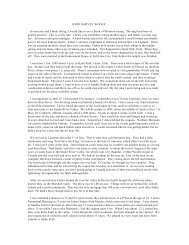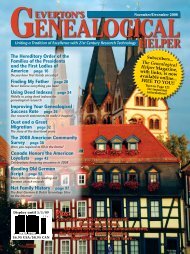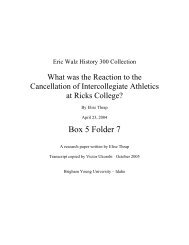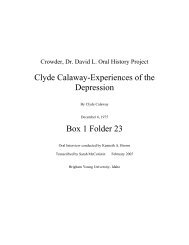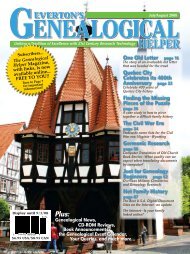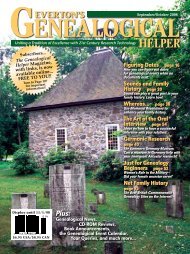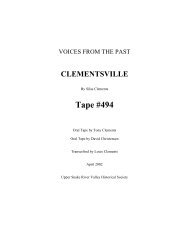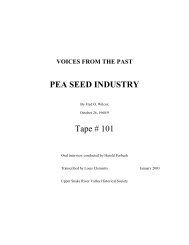HelPeR - BYU Idaho Special Collections and Family History
HelPeR - BYU Idaho Special Collections and Family History
HelPeR - BYU Idaho Special Collections and Family History
Create successful ePaper yourself
Turn your PDF publications into a flip-book with our unique Google optimized e-Paper software.
Ancesto Stories for the Soul<br />
Of course I was on the lookout for the Wisconsin<br />
monument <strong>and</strong> the marker for John’s unit. And<br />
there they were! The Wisconsin monument was huge,<br />
towering hundreds of feet high, <strong>and</strong> it listed all of<br />
the soldiers in all of the units from that state who<br />
fought there. John’s name was among them, listed<br />
with Company A of the 14th Infantry Regiment.<br />
I can recall, even now, the eerie feeling I had<br />
as I looked at his name there among those of his<br />
comrades. The quest that began at some low level<br />
of interest nearly 30 years prior was now building<br />
to a crescendo that caused me to feel excited, nervous,<br />
<strong>and</strong> also filled with awe <strong>and</strong> respect. Seeing<br />
his name there caused me to feel connected to that<br />
historic place <strong>and</strong> time in a way I never thought<br />
possible.<br />
One half mile further on I found the marker that<br />
represented his unit’s place in the Union line. It was<br />
approximately here, in an assault on 22 May 1863,<br />
that my great-gr<strong>and</strong>uncle was killed.<br />
How it Ended (The Cemetery)<br />
The National Cemetery is at the northern end of the<br />
park on a high bluff overlooking the river, <strong>and</strong> at the<br />
place where the park road leaves the Union lines <strong>and</strong><br />
doubles back to follow the Confederate positions. It is<br />
a large, tiered plot of ground that covers 116 acres.<br />
To appreciate the cemetery, one has to know some<br />
of its history. It is the final resting place of some<br />
17,000 Union soldiers. This is the largest number of<br />
Union burials among all of the national cemeteries.<br />
(The Confederate dead are buried in cemeteries in the<br />
city itself, or removed to other locations closer to the<br />
soldier’s homes.) The Cemetery was not established<br />
<strong>and</strong> made available for burials until 1866, three years<br />
after the action at Vicksburg. All during the Civil War,<br />
hasty burials were made near the places where battles<br />
were fought. At the end of the War, those soldiers<br />
were re-interred at national cemeteries.<br />
Most of the soldiers buried at Vicksburg came<br />
from temporary burial sites in Arkansas, Louisiana,<br />
<strong>and</strong> Mississippi. Record keeping was not at its best<br />
during wartime <strong>and</strong> grave locations were often lost,<br />
<strong>and</strong> compounding that, the identities of those whose<br />
bodies were fortunate enough to be recovered were<br />
also often lost. In the south during the campaign<br />
for control of the Mississippi River there was even<br />
a further compounding problem: the River would<br />
periodically overflow its banks <strong>and</strong> wash the hastily<br />
dug graves away. It was often simply unidentified<br />
piles of bones that were collected <strong>and</strong> buried at the<br />
national cemetery.<br />
At Vicksburg, 75 percent of the dead are unidentified:<br />
almost 13,000 graves. I was suddenly very<br />
thankful for the twists of fate that caused John’s<br />
grave to be among the known. Those that are unknown<br />
are marked with small rectangular blocks<br />
of stone while the graves of those whose name is<br />
known have traditional tablet-like headstones. It is<br />
tremendously sobering to look over the cemetery<br />
<strong>and</strong> see so few headstones. I could only imagine the<br />
anguish of the families of those fallen soldiers, families<br />
who never had the closure brought by burying<br />
their loved ones, or of even knowing for sure where<br />
their graves were located.<br />
But John was among the known dead. This was<br />
probably due to the fact that he was killed at Vicksburg<br />
itself, ground controlled by a Union victory,<br />
<strong>and</strong> ground high above the river <strong>and</strong> thus protected<br />
from it.<br />
The rangers at the visitor’s center were helpful<br />
in locating his grave. I had the number on the<br />
54 © Ev e r t o n’s Ge n e a l o g i c a l He l p e r Ja n ua ry/Fe b r u a r y 2009


